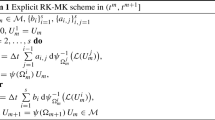Abstract
Reduced basis methods are popular for approximately solving large and complex systems of differential equations. However, conventional reduced basis methods do not generally preserve conservation laws and symmetries of the full order model. Here, we present an approach for reduced model construction, that preserves the symplectic symmetry of dissipative Hamiltonian systems. The method constructs a closed reduced Hamiltonian system by coupling the full model with a canonical heat bath. This allows the reduced system to be integrated with a symplectic integrator, resulting in a correct dissipation of energy, preservation of the total energy and, ultimately, it helps conserving the stability of the solution. Accuracy and stability of the method are illustrated through the numerical simulation of the dissipative wave equation and a port-Hamiltonian model of an electric circuit.




Similar content being viewed by others
References
Afkham, B.M., Hesthaven, J.S.: Structure preserving model reduction of parametric Hamiltonian systems. SIAM J. Sci. Comput. 39, A2616–A2644 (2017)
Amsallem, D., Farhat, C.: On the Stability of Reduced-Order Linearized Computational Fluid Dynamics Models Based on POD and Galerkin Projection: Descriptor Vs. Non-descriptor Forms, in Reduced Order Methods for Modeling and Computational Reduction, pp. 215–233. Springer, Cham (2014)
Beattie, C, Gugercin, S.: Structure-preserving model reduction for nonlinear port-Hamiltonian systems. In: 2011 50th IEEE Conference on Decision and Control and European Control Conference (CDC-ECC), pp. 6564–6569. IEEE (2011)
Bhatia, N., Szegö, G.: Stability Theory of Dynamical Systems, Classics in Mathematics. Springer, Berlin (2002)
Carlberg, K., Tuminaro, R., Boggs, P.: Preserving Lagrangian structure in nonlinear model reduction with application to structural dynamics. SIAM J. Sci. Comput. 37, B153–B184 (2015)
Chaturantabut, S., Beattie, C., Gugercin, S.: Structure-preserving model reduction for nonlinear port-Hamiltonian systems. SIAM J. Sci. Comput. 38, B837–B865 (2016)
Chaturantabut, S., Sorensen, D.C.: Nonlinear model reduction via discrete empirical interpolation. SIAM J. Sci. Comput. 32, 2737–2764 (2010)
Corduneanu, C.: Integral Equations and Applications, vol. 148. Cambridge University Press, Cambridge (1991)
da Silva, A.: Introduction to Symplectic and Hamiltonian Geometry. Publicações matemáticas, IMPA, New York (2003)
de Gosson, M.: Symplectic Geometry and Quantum Mechanics, Operator Theory: Advances and Applications. Birkhäuser, Basel (2006)
Figotin, A., Schenker, J.H.: Spectral theory of time dispersive and dissipative systems. Stat. Phys. 118, 199–263 (2005)
Figotin, A., Schenker, J.H.: Hamiltonian structure for dispersive and dissipative dynamical systems. J. Stat. Phys. 128(4), 969–1056 (2007)
Hairer, E., Lubich, C., Wanner, G.: Geometric Numerical Integration: Structure-Preserving Algorithms for Ordinary Differential Equations, 2nd edn. Springer, Dordrecht (2006)
Hesthaven, J., Rozza, G., Stamm, B.: Certified Reduced Basis Methods for Parametrized Partial Differential Equations, Springer Briefs in Mathematics. Springer International Publishing, Berlin (2015)
Ito, K., Ravindran, S.S.: A Reduced Basis Method for Control Problems Governed by PDEs, in Control and Estimation of Distributed Parameter Systems (Vorau, 1996), pp. 153–168. Birkhäuser, Basel (1996)
Ito, K., Ravindran, S.S.: A reduced-order method for simulation and control of fluid flows. J. Comput. Phys. 143, 403–425 (1998)
Ito, K., Ravindran, S.S.: Reduced basis method for optimal control of unsteady viscous flows. Int. J. Comput. Fluid Dyn. 15, 97–113 (2001)
Karow, M., Kressner, D., Tisseur, F.: Structured eigenvalue condition numbers. SIAM J. Matrix Anal. Appl. 28, 1052–1068 (2006). (electronic)
Lall, S., Krysl, P., Marsden, J.E.: Structure-preserving model reduction for mechanical systems. Physica D 184, 304–318 (2003)
Lamb, H.: On a peculiarity of the wave-system due to the free vibrations of a nucleus in an extended medium. Proc. Lond. Math. Soc. XXXII, 208–211 (1900)
Marsden, J.E., Ratiu, T.S.: Introduction to Mechanics and Symmetry: A Basic Exposition of Classical Mechanical Systems. Springer Publishing Company, Berlin (2010)
Peng, L., Mohseni, K.: Geometric model reduction of forced and dissipative Hamiltonian systems. In: 2016 IEEE 55th Conference on Decision and Control (CDC), pp. 7465–7470. IEEE (2016)
Peng, L., Mohseni, K.: Symplectic model reduction of Hamiltonian systems. SIAM J. Sci. Comput. 38, A1–A27 (2016)
Polyuga, R.V., van der Schaft, A.: Structure preserving model reduction of port-Hamiltonian systems by moment matching at infinity. Autom. J. IFAC Int. Fed. Autom. Control 46, 665–672 (2010)
Prajna, S.: Pod model reduction with stability guarantee. In: 2003. Proceedings. 42nd IEEE Conference on Decision and Control, vol. 5, pp. 5254–5258. IEEE (2003)
Quarteroni, A., Manzoni, A., Negri, F.: Reduced Basis Methods for Partial Differential Equations: An Introduction, UNITEXT. Springer International Publishing, Berlin (2015)
Salam, A., Al-Aidarous, E.: Equivalence between modified symplectic Gram–Schmidt and Householder SR algorithms. BIT Numer. Math. 54, 283–302 (2014)
Strang, G.: Introduction to Linear Algebra, 4th edn. Wellesley-Cambridge Press, Wellesley (2009)
van der Schaft, A.: L\(_{2}\)-Gain and Passivity Techniques in Nonlinear Control, Vol. 218 of Lecture Notes in Control and Information Sciences. Springer, London (1996)
van der Schaft, A., Jeltsema, D.: Port-Hamiltonian systems theory: an introductory overview. Found. Trends Syst. Control 1, 173–378 (2014)
Willems, J.C.: Dissipative dynamical systems. II. Linear systems with quadratic supply rates. Arch. Ration. Mech. Anal. 45, 352–393 (1972)
Acknowledgements
This work was partially supported by AFOSR under contract FA9550-17-1-0241.
Author information
Authors and Affiliations
Corresponding author
Rights and permissions
About this article
Cite this article
Maboudi Afkham, B., Hesthaven, J.S. Structure-Preserving Model-Reduction of Dissipative Hamiltonian Systems. J Sci Comput 81, 3–21 (2019). https://doi.org/10.1007/s10915-018-0653-6
Received:
Revised:
Accepted:
Published:
Issue Date:
DOI: https://doi.org/10.1007/s10915-018-0653-6




